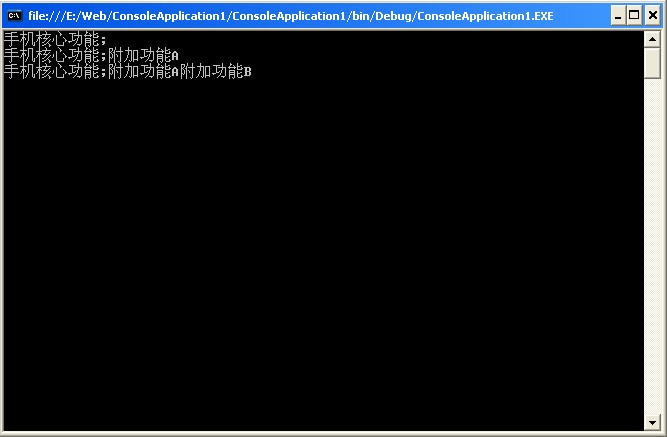装饰模式:动态地为一个对象增加一些额外的职责。
就增加功能来说,装饰模式比生成子类更加灵活
下图为装饰模式的结构图:

Component: 定义了一个对象的接口,使得可以为这些对象动态的增添一些额外的功能。
ConcreteComponent: 核心功能类,描述对象的具体功能。比如手机类的核心功能——通话功能。
Decorator: 装饰抽象类,继承自Component,从而可以扩展Component的功能。
ConcreteComponentA: 具体装饰类A,可以为Component扩展一些功能,比如手机类的扩展功能——拍摄功能。
ConcreteComponentB: 具体装饰类B,作用同上。
定义代码如下:
 代码
代码
abstract class Component
{
private string _functions;
public string Functions
{
get { return this._functions; }
set { this._functions = value; }
}
public abstract string ShowFunctions();
}
class ConcreteComponent : Component
{
public ConcreteComponent()
{
this.Functions += "手机核心功能;";
}
public override string ShowFunctions()
{
return this.Functions;
}
}
class Decorator : Component
{
protected Component component;
public void SetComponent(Component component)
{
this.component = component;
}
public override string ShowFunctions()
{
if (this.component != null)
{
return this.component.ShowFunctions();
}
else return "无功能";
}
}
class ConcreteDecoratorA : Decorator
{
public override string ShowFunctions()
{
this.component.Functions += "附加功能A";
return base.ShowFunctions();
}
}
class ConcreteDecoratorB : Decorator
{
public override string ShowFunctions()
{
this.component.Functions += "附加功能B";
return base.ShowFunctions();
}
}
{
private string _functions;
public string Functions
{
get { return this._functions; }
set { this._functions = value; }
}
public abstract string ShowFunctions();
}
class ConcreteComponent : Component
{
public ConcreteComponent()
{
this.Functions += "手机核心功能;";
}
public override string ShowFunctions()
{
return this.Functions;
}
}
class Decorator : Component
{
protected Component component;
public void SetComponent(Component component)
{
this.component = component;
}
public override string ShowFunctions()
{
if (this.component != null)
{
return this.component.ShowFunctions();
}
else return "无功能";
}
}
class ConcreteDecoratorA : Decorator
{
public override string ShowFunctions()
{
this.component.Functions += "附加功能A";
return base.ShowFunctions();
}
}
class ConcreteDecoratorB : Decorator
{
public override string ShowFunctions()
{
this.component.Functions += "附加功能B";
return base.ShowFunctions();
}
}
在控制台运行代码:
 代码
代码
static void Main(string[] args)
{
//手机类 具有基本功能
ConcreteComponent phone = new ConcreteComponent();
//展示手机现在功能
Console.WriteLine(phone.ShowFunctions());
//修饰类A 具有修饰功能A 使之修饰手机phone
ConcreteDecoratorA decoratorA = new ConcreteDecoratorA();
decoratorA.SetComponent(phone);
//展示手机现在功能
Console.WriteLine(decoratorA.ShowFunctions());
//修饰类B 具有修饰功能B 使之修饰手机phone
ConcreteDecoratorB decoratorB = new ConcreteDecoratorB();
decoratorB.SetComponent(phone);
//展示手机现在功能
Console.WriteLine(decoratorB.ShowFunctions());
Console.ReadKey();
}
{
//手机类 具有基本功能
ConcreteComponent phone = new ConcreteComponent();
//展示手机现在功能
Console.WriteLine(phone.ShowFunctions());
//修饰类A 具有修饰功能A 使之修饰手机phone
ConcreteDecoratorA decoratorA = new ConcreteDecoratorA();
decoratorA.SetComponent(phone);
//展示手机现在功能
Console.WriteLine(decoratorA.ShowFunctions());
//修饰类B 具有修饰功能B 使之修饰手机phone
ConcreteDecoratorB decoratorB = new ConcreteDecoratorB();
decoratorB.SetComponent(phone);
//展示手机现在功能
Console.WriteLine(decoratorB.ShowFunctions());
Console.ReadKey();
}
运行结果:

在结果上可以看出,Component被子类一层一层的包装了,这就是装饰模式。
换个例子可能更直观,我们把Component类看成人,ConcreteComponentA,ConcreteComponentB 看成不同的衣服,比如内衣,外套,鞋子等。
这样我们可以任意搭配自己的服装,得到想要的结果。
实际上装饰模式是为了为已有模式动态添加更多功能的方式。
装饰模式最大的好处在于把类中用于修饰的代码移除,而只剩下类最核心的功能,这样简化了原来的类。
在扩展修饰功能时也更方便直观。




 浙公网安备 33010602011771号
浙公网安备 33010602011771号